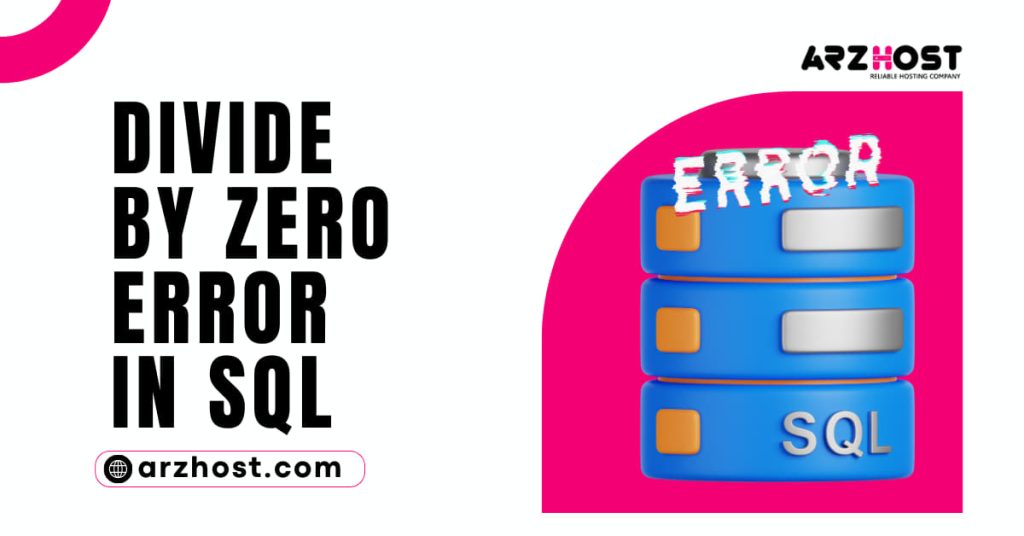Lately, one of our customers ran over this error as it is inconceivable to hope to isolate a number by nothing. It prompts immeasurability. We perform data calculations in SQL Server for various considerations.
As a component of your Server Management Services, we assist our customers with a couple of SQL requests. Today, “Divide by Zero Error Encountered.SQL”, around here at ARZHOST, let us see how to fix this slip-up.
Cause for the error ‘SQL Server parcel by zero error experienced’
“Divide by Zero Error Encountered.SQL”, Permit us to see what could cause the error ‘SQL Server parcel by zero missteps experienced’.
As a matter of first importance, If the product2 sum leaves stock and that suggests we don’t have any sum for product2.
Declare @Product1 INT;Declare @Product2 INT;SET @Product1 = 50;SET @Product2 = 0;SELECT @Product1/@Product2 Product Ratio;
“Divide by Zero Error Encountered.SQL”, We get SQL parcel by zero error messages (message id 8134, level 16):
Msg 8134, Level 16, State 1, Line 13Hole by zero error experienced.
How to address the error ‘SQL Server parcel by zero error experienced’?
Consistently, “Divide by Zero Error Encountered.SQL”, is a best practice to form code to not give segment by zero message. It should have an instrument to oversee such conditions.
Pushing forward, let us see incredible techniques followed by our Hosting Expert Designers use to handle this error.
Procedure 1: SQL NULLIF Function
From the get-go, “Divide by Zero Error Encountered.SQL”, we use NULLIF ability to avoid segment by zero error message.
The semantic construction of NULLIF work:
NULLIF (expression1, expression2)
It recognizes two disputes.
- First thing, if both the disputes are the same, it returns an invalid worth
“Divide by Zero Error Encountered.SQL”, For example, accept that the value of the two conflicts is 10.
SELECT NULLIF (10, 10) result;
For the present circumstance, the yield will be invalid.
- Second thing, if both the conflicts are not the same, it returns the value of the principal dispute.
In this model, “Divide by Zero Error Encountered.SQL”, both disputes regards to contrast. It returns the yield as the worth of the first conflict 10.
SELECT NULLIF (10, 5) result;
We can change our fundamental inquiry using the SQL NULLIF explanation. We place the going with reasoning using NULLIF work for taking out SQL segment by zero botches:
- Use NULLIF work in the denominator with second dispute regard zero
- In the event that the worth of the key question is besides zero, this cutoff returns an invalid worth. In SQL Server, if we package a number with invalid, the yield is invalid in addition.
- On the off chance that the worth of the significant clash isn’t zero, it returns the essential question worth and division happens as standard qualities.
-
Report @Product1 INT;Declare @Product2 INT;@Product1 = 50;SET @Product2 = 0;
SELECT @Product1/NULLIF(@Product2,0) Product Ratio;
Execute this modified request. “Divide by Zero Error Encountered.SQL”, We will get the yield as NULL since the denominator contains zero.
If we needn’t bother with the invalid worth in the yield, we can use SQL ISNULL ability to avoid invalid characteristics in the yield and show an unmistakable worth. This limit replaces the invalid worth in expression1 and returns expression2 regard as yield.
Procedure 2: Using CASE enunciation to avoid segment by zero error
Additionally, you can use a CASE verbalization in SQL to return regards subject to express conditions. “Divide by Zero Error Encountered.SQL”, The Case clarification checks for the value of @Product2 limit:
 If the @Product2 regard is zero, it brings an invalid back.
If the @Product2 regard is zero, it brings an invalid back.- In case the above condition isn’t satisfied, it does the calculating movement (@Product1/@Product2) and returns the yield.
Report @Product1 INT;Report @Product2 INT;SET @Product1 = 50;SET @Product2 = 0;- SELECT CASE
Right when @Product2 = 0Then, NULLELSE @Product1/@Product2END AS Product Ratio;
“Divide by Zero Error Encountered.SQL”, We will get yield as NULL.
Procedure 3: SET ARITHABORT OFF
As usual, SQL Server has a default worth of SET ARITHABORT is ON. “Divide by Zero Error Encountered.SQL”, We get SQL segment by zero error in the yield using the default directly.
The T-SQL language for controlling the ARITHABORT decision is shown underneath:
SET ARITHABORT {ON | OFF}
Using ARITHABORT ON, the inquiry will end with a parcel with zero message. It is the default lead.
SET ARITHABORT ON — DefaultSET ANSI_WARNINGS ONAnnounce @Product1 INT;Announce @Product2 INT;SET @Product1 = 50;@Product2 = 0;SELECT @Product1/@Product2 Product Ratio;
We get the SQL segment by zero error messages.
Using ARITHABORT OFF, “Divide by Zero Error Encountered.SQL”, the bunch will end and returns an invalid worth. We truly need to use ARITHABORT in blend in with SET ANSI_WARNINGS OFF to avoid the error message:
SET ARITHABORT OFFSET ANSI_WARNINGS OFFAnnounce @Product1 INT;Announce @Product2 INT;SET @Product1 = 50;SET @Product2 = 0;SELECT @Product1/@Product2 Product Ratio;
“Divide by Zero Error Encountered.SQL”, We will get the yield as NULL.
You can use the going with a request to truly check out the current definition for the ARITHABORT limit:
Articulate @ARITHABORT VARCHAR (3) = 'OFF';In the event that ((64 and @@OPTIONS) = 64) SET @ARITHABORT = 'ON';SELECT @ARITHABORT AS ARITHABORT;
The default ARITHABORT setting for SQL Server Management Studio (SSMS) is ON. We can see it using SSMS Tools properties. Investigate to Tools – > Options – > Advanced.
We should not change the value of ARITHABORT aside from whenever required. It might make performance issues, “Divide by Zero Error Encountered.SQL”, as well. It is more intelligent to use various techniques for avoiding SQL segment by zero error.
Termination
“Divide by Zero Error Encountered.SQL”, we saw how our Hosting Professional Developers settle screw-up SQL Server parcel by zero missteps experienced.
People Also Ask
Question # 1: What is divided by zero error SQL?
Answer: Server: Msg 8134, Level 16, State 1, Line 1 Divide by zero error encountered. Causes: This error is caused by performing a division operation wherein the denominator or the divisor is 0. This error is not encountered when the denominator or divisor is NULL because this will result in a NULL value.
Question # 2: What will you do to handle divide by zero in a SQL query?
Answer: If you’d like to handle division by zero gracefully, you can use the NULLIF function. NULLIF takes two arguments: the expression of interest and the value you want to override. If the first argument is equal to the second, then NULLIF returns NULL; otherwise, it returns the first argument.
Question # 3: Why can’t we divide by zero?
Answer: These notes discuss why we cannot divide by 0. The short answer is that 0 has no multiplicative inverse, and any attempt to define a real number as the multiplicative inverse of 0 would result in the contradiction 0 = 1. These notes may be useful for anyone with questions about dividing by 0.
Question # 4: Can I divide by zero?
Answer: It is well known that you cannot divide a number by zero. Math teachers write, for example, 24 ÷ 0 = undefined. They use analogies to convince students that it is impossible and meaningless, that “you cannot divide something by nothing.” Yet we also learn that we can multiply by zero, add zero, and subtract zero.
Question # 5: How do you stop a division by zero in Matlab?
Answer: If you want to avoid division by 0, you need to make sure the denominator cannot possibly be 0 for any useful data range (and you have to test the data to be sure it does not violate the constraint); OR, you need to calculate the denominator first and test whether it is non-zero enough before you go ahead.









